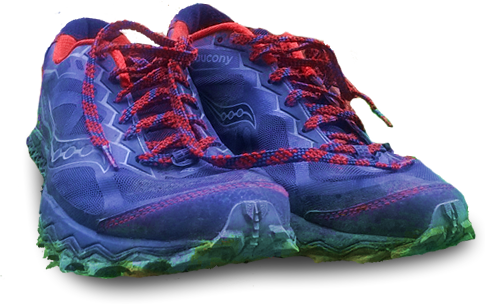Transvulcania 2015
10th May, 2015
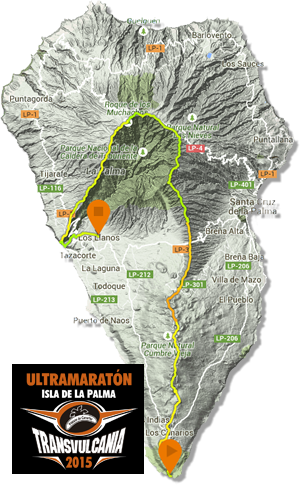 This race earned its place in my bucket list ever since seeing a YouTube video of the start a couple of years back. The image of a river of headtorch lightrails streaming up the climb out of Fuencaliente in the pre dawn sealed the deal for me there and then.
This race earned its place in my bucket list ever since seeing a YouTube video of the start a couple of years back. The image of a river of headtorch lightrails streaming up the climb out of Fuencaliente in the pre dawn sealed the deal for me there and then. I'm sitting on a bench in the town square, the finish gantry and podium backdrop the only props left from Saturday's carnival. I'm trying to recall exactly what it felt like 48 hours ago when instead of having crossed the finish line as I had expected, I was still hours away, slogging up the brutal climb to the 2,400m peak of Roque de los Muchachos under the punishing sun and without a molecule of water to my name.
It's curious how an event that has you on your feet and pushed to the limit for so many hours quickly fades into a few disjointed memories. Maybe this is a self-defence mechanism? I've hardly even got an ache now and I'm half tempted to go and look at that final climb into Los Llanos which nearly finished me off at the time, just to see if it really is that hard!
Anyway, better start with some kind of introduction to the race for anyone new to it, though it has such a high profile now and attracts the best ultra running athletes that if this is your sport, you've almost certainly already heard about it.
Transvulcania has existed since 2009 and in the 73.3km Ultra form, is a run from the Fuencaliente Lighthouse on the Southern tip of La Palma at sea level and rising rapidly up and over the volcanic spine of the island, encircling the astounding Taburiente crater up to over 2,400m, rapidly plummeting back to the sea at Tazacorte before a last 5k uphill to Los Lllanos. It's not just an ultra - there are also half marathon and marathon options (both longer than 'standard' distances and a lot tougher) which use sections of the full ultra course. And, two days before the main event there's a vertical kilometer (VK) race from Tazacorte up to the penultimate ultra aid station at El Time - about 6.6km away and 1,100m up.

It attracts the best - Emelie Forsberg is back again (injured out last time, winner the previous year), Luis Hernando (previous winner and second place finisher) plus a host of the cream - Timmy Olson, Dakota Jones. Anna Frost was due to run too but due to illness ran the VK (as did Emelie). Basically anyone who's anyone has run or is running this.
I'd flown to New Zealand back in April and landing in La Palma was kind of similar to seeing the Queenstown landing strip laid out in front of the Remarkables - you can't help but stare. Most of my fellow passangers on the small propeller-driven plane were obviously here to race too and the airstrip was soon littered with people taking selfies with the mountain range.
This is a small island and the course along the ridge dominates the landscape. My cabbie from Santa Cruz Airport to Los Llanos took great delight in pointing out the trail on the skyline as we drove ever upwards into the mountains - we seemed to be climbing switchbacks forever and yet the mountain remained towering above, undiminished. He told me how much he loved the place - there are only around 100,000 people on the island and he says there's no trouble. He'd spent a year in Watford so I gave him credit for being able to discern the difference between trouble and not trouble. Having been here for a few days I can see where he's coming from. Everyone seems to know everyone else, there's spontaneous conversations on park benches in the square, and they're all friendly to dumb non-Spanish speakers like me. Two other things going for it - it's not got the pull of Tenerife for the Brits and is thus unspoilt, plus it's super cheap!
Me, Lucja and Marina all stayed in the same apartment block (the Apartamentos Adjovimar - highly recommended) and the ridge looms impossibly large as a backdrop to the whole place. It looks other-wordly in the mist and it's still as awe-inspiring looking at it now. I realised I'd certainly never run anything like this before despite getting in what specific training I could manage.
Vertical Kilometer
We decided watching the VK race on the Thursday offered a good chance to go and recce that part of the course (I was more concerned about the switchback, cliff edge descent there than anything else - very wrongly as it turned out!) and watch the fun. We took in the expo first which was a pretty minimal affair (fine by me) and included the use of a Champion Chip that looked like it had just been excavated from somewhere and a gilet so orange I doubt I'll be able to carry it off around Eton Wick.
The switchbacks rise 200m from the beach and looked vertigo-inducing from sea level but in fact weren't as narrow as I'd feared. Of course coming down them after 40 miles of running would be a different matter.. I had a go with the poles I'd bought especially for the race (not great planning there) and they weren't at all bad so that was a false sense of security instilled.
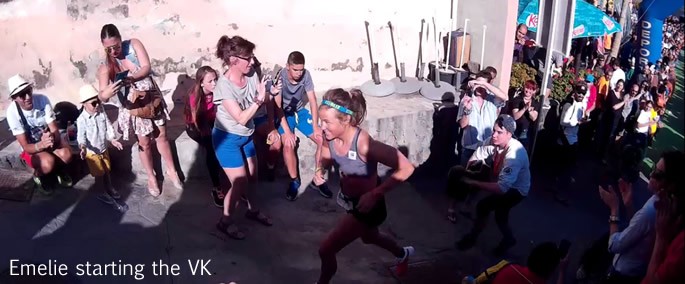
The VK was an experience - about 100 or so had entered and they're set off individually at roughly minute intervals with the best (Frosty, Forsberg) saved til last. There's a big crowd out, a compere from the Michael Buffer school but on steroids and you can get right up to within touching distance to the runners. I didn't follow the results I have to admit but apparently the elite winner takes over an hour! For 6.6km! It's no pushover.
Transvulcania
Race day and we get a cab instead of the race bus which saves a walk to said bus and allows for an extra 90 minutes sleep. Or what passes for sleep.
The fare quoted in advance was 45 Euros but by the time we reached the lighthouse it was up close to 60. Incredibly the cabbie said 'it's still 45'! Can you imagine that back home - 'It's whatever's on the meter, mate'.
It's pitch black - nights seem especially dark here, compounded by the black volcanic sand as there's nothing reflective in sight - and about an hour before the kickoff. By the time the portaloo has been christened, most have lined up already and the PA is working them into a frenzy with AC/DC's Back in Black as the time to go counts down, projected onto a rock face.
Then it's Thunderstruck - what Chariots of Fire is to Comrades - and everyone's ready to raise hell by the time the 10 second countdown starts and the gun fires.
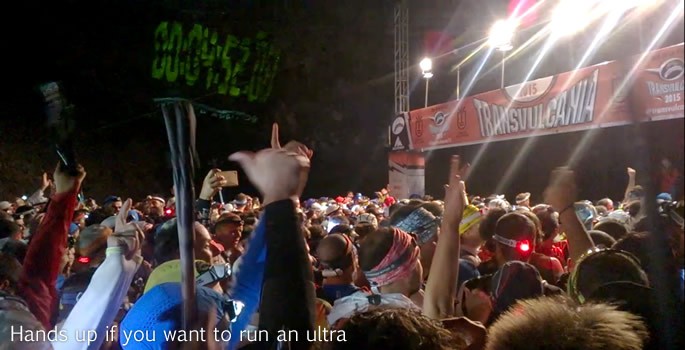
Headtorches ablaze, 1,500 flood across the start and immediately start the climb up the loose ash towards the invisible peak providing spectators with that iconic sight of a trail of light snaking up the volcano. It's a narrow path here and difficult to get going - you have to be patient, especially as this stuff is as sharp as glass and you don't want to go over on it. As we climb I take the chance to look back and it's a real spectacle - pinpoints of light dancing like fireflies in the inky blackness stretching back to the sea.
It's pretty steep for the first few kilometres and with the press of people there's not a lot of running going on but I take what chance there is to run alongside the trail to slip past a bottleneck or two. Some take more drastic measures as the trail winds left and right and head straight up cutting out the turn but the path surface is pretty sketchy as is let alone the off-piste stuff.
There are runnable sections so I stretch out when I can, keeping an eye on the alitmeter on the Ambit as I know the frst checkpoint is at about 700m above sea level. Unusually I navigated this race entirely by a temporary tattoo of the course elevation profile, purchased at the expo! The Ambit was never going to last the distance following a GPS trace so I set it on its least accurate/longest battery life mode and decided watching altitude was a good way of working out whereabouts I was. Three days on and the tat has finally relinquished its grip on my forearm. Also impressive, post race, the watch still had 2/3rds of its battery left which given that I don't normally get 6 hours out of it is amazing.
Worryingly before I'd got very far at all I was sweating and that was not a good omen. I'd scrutinised the forecast for days beforehand and it didn't look bad - low 20s as opposed to the potential 30s C but when you ditch your disposables at the start and you're still plenty warm enough you've got trouble.
The first aid station is Los Canarios, a town perched on the steep hillside and despite it being well before sunup, the whole town is out cheering on, music blaring. I think this is something as a resident you've either got to get involved in or move away to stay with relatives like Londoners during the Olympics. You're not sleeping through that. It's just a water stop and I grab a gulp or two and press on quite grateful for the tarmac underfoot after all the loose sand.
At some point between here and the next aid station, 1900m above sea level, the sun came up but I have absolutely no recollection of the sunrise - it's probably as quick as the sunset which is like switching off a light here. The trail is better and this section is now forest rather than the bare slopes at the start but it's still very steep, there's still loads of ash and rock but with a few pine needles thrown in to soften the blow.
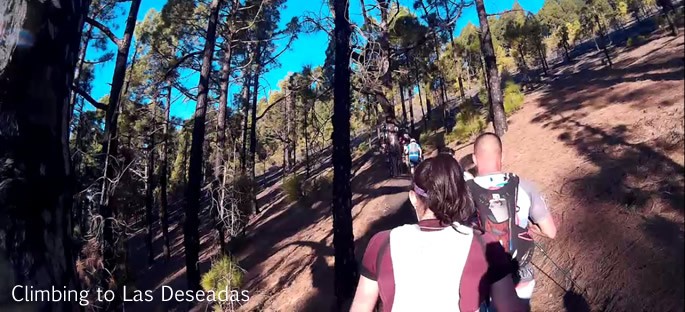
The race climbs 1,900 metres in the first 18km, up to the second aid station at Las Deseadas - greater than 10% on average for 11 miles - and we are soon running way above the clouds.
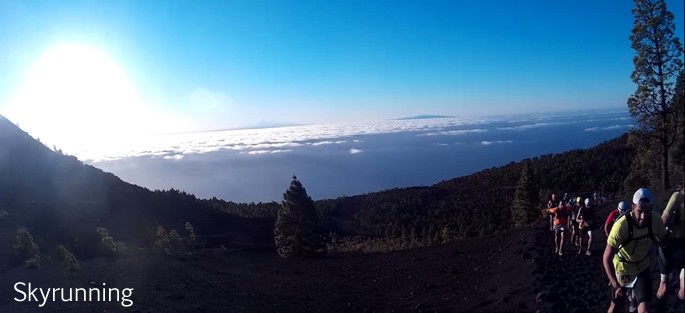
I hadn't learnt one of the main takeaway lessons of this run by aid stop 2. That is when considering how far the next checkpoint and therefore water station is, don't be saying dumb things like 'it's only 4 miles, I'll be there in no time so I don't need a top-up'. In this heat - and we seem to have suddenly turned up the dial a very long way by this point - and with these gradients a handful of miles can take hours, but I'm doing ok at this point though I've actually no idea how fast I'm going overall. 'Fast' is probably the wrong word.
The aid station is just a tent and I press on knowing the next section down to Refugio de El Pilar is the most runnable section of the whole race, about 5 miles away and 500 metres lower. It seems a shame to lose all that hard-won altitude but the reward is some of the most sublime views I've ever had the good fortune to set my eyes on. From our vantage point 2,000 metres above the sea, the whole course is laid out before us. The crater rim and peak of Roque de Los Muchachos with its dramatic descent to Tazacorte far in the distance, and all of which we will run. It had been been hard and would get much harder but this was a gleeful headlong dash downhill with the deep black sand cushioning against the steep slope and the heady scent of blossoming plants everywhere.
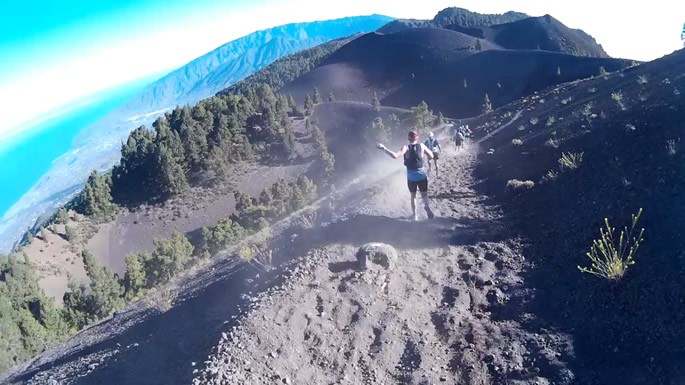
But still there was that sun and though there's a brief respite from it coming in to El Pilar which is deep in the trees, since it rose it's been boring into the trail and I'm starting to feel the effects.
Refugio de El Pilar is a bustling mass of humanity with the finish line of the half marathon here, hordes of spectators and feeding station for us lot who have another 30 miles to go. I fill everything that can be filled from the generously-laden benches including shoving down a hundredweight of melon slices (lovely) and some local version of Haribo. Having seen what happened to Richard Ashton's feet last year, thanks ironically to a ton of ash, I decided to empty the shoes of lava. Despite long socks, calf guards and gaiters a huge amount fell out of each shoe. This stuff is so fine it gets absolutely everywhere.
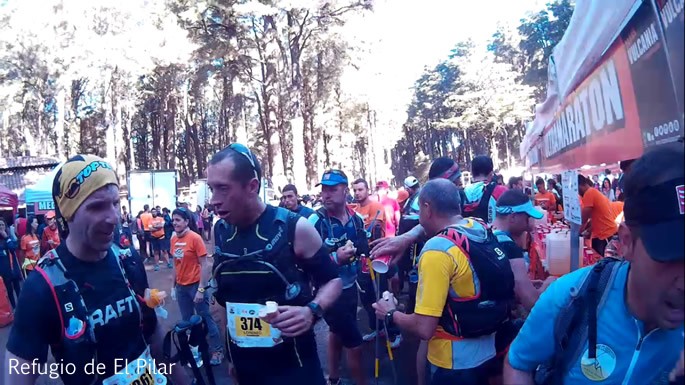
I spent a good 15 minutes at El Pilar and felt like I'd run a lot more than a third of the race when I set off again. From here to El Reventon, 7.5km away, it's largely hard-packed trail without too many uphills so I made reasonable progress but the sun was starting to take its toll and I was drinking ever more water. I'd had this happen twice at Comrades but nothing like so early in the race. No matter what you drink the thirst is always there and the back of the throat is dry and cracked. There was brief respite at each aid station where a jug of cold water poured over the back of your neck is on offer which feels amazing and revitalises in an instant though the effect is shortlived.
I stupidly didn't totally fill my bladder at this point, ridiculously falling into the trap of thinking that 12.5km to the next aid station isn't that far, why bother taking everything off for a few extra centilitres? This is where the course goes for the jugular. This is the long climb up to the highest point of the course at Roque de Los Muchachos and it nearly broke me.
It wasn't the legs, I was still running fine when the course allowed, but hiking uphill was proving to be incredibly hard. There were many times I couldn't go more than a few tens of metres without sitting down or bending double hanging limply from my poles. Deep panting ensued as soon as the walking stopped like it had just been an all out sprint. My chest felt very constricted and I really began to worry if i was doing myself some damage. It could have been the altitude I thought and as we were at 2,000m and had another 500 to climb that was a big worry. I think now it was heat exhaustion, no doubt compounded by thinner air. I've never felt so debilitated. This really was turning into a death march - some were handling it much better than others but when I was moving it was in a slowly-trudging line like we were all manacled together, staggering through the desert on our last knockings. Time lost all meaning and I had no idea how far we'd gone or had to go. There seemed no end to the up and it was false summit after false summit climbing very steep zig-zag paths.
One kindly Spanish fella saw my atrocious state and said 'it goes down soon.. a little.. a little (doing that universal thumb and first finger gesture earnestly).. in 1 km'. At this pace, that could have been an hour away. It's a strange subdued atmosphere, no doubt because everyone is feeling it, but there's very little talking except the occasional 'venga!' and 'vamoss!' to gee up those taking a breather. The suffering is in stark contrast to the views of the crater which are astounding if only one had the capacity to enjoy them.
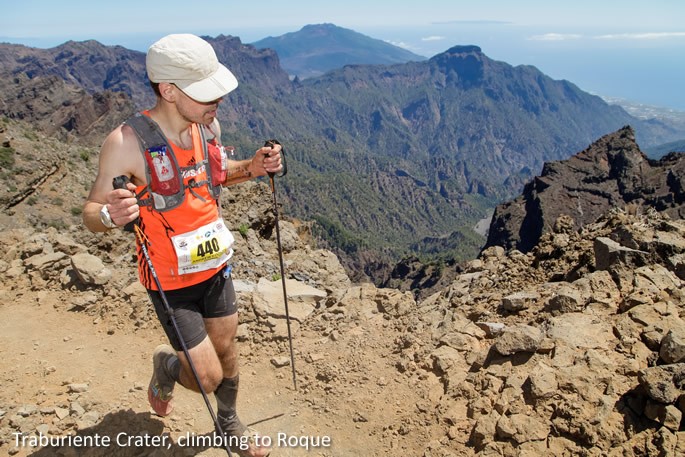
My memory of the section is very hazy. When the advertised little bit down section came I was back running again and feeling much better - it was literally a few degrees difference either way that meant clipping along or fearing a heart attack.
I remember coming across a water station that I wasn't expecting and it appearing like a mirage on the trail above me. And frankly, as I'd run out of water that saved me from a DNF right there. I'm sure aid point distances were no longer matching up to the hitherto reliable tattoo map, but that's hardly the race organisers' fault! Something tells me they realised there wasn't enough water on the course - they'd dropped an aid station from previous incarnations of this race and everyone was running out - and put an extra stop in.
In the space of 5km from 38 - 43km I shipped nearly 400 places and that's out of under 1,400 finishers so things must have been even worse than I remember! Reachng the next aid station at Pico de la Cruz was an interminable trial. I was still 'navigating' by altitude and things had settled at around the height of the aid point by then and a series of mini peaks nearly reached the magic altitude only to fall away before climbing again. There was also a timing mat point, the red umbrella of which I saw from below and assumed, wrongly, that was the CP! Desperate!
Fortunately, someone came down the trail with water beyond that point and that was another lifesaver. I could have polished off the bottle but it was meant for everyone of course. Finally reaching Pico de la Cruz, I rested up for 10 minutes, drank about a litre of Coke and thought some real food would help but the ham and cheese sandwich was extremely dry and I chucked it, half finished.
I had contemplated dropping out at Roque de Los Muchachos as I was in bits and my time was hopelessly adrift but this is Transvulcania for one, I wasn't actually injured for two and for three reaching Roque meant the start of the descent so why do all the work and then drop? Reaching Roque from Pico, preceded by the cluster of observatories was a very difficult slog - both because of the relentless heat and the very gnarly trail. I was still having to stop and recover far too often to get any kind of rhythmn going.
There were few runners on the trail at this stage - bunched into trains of 6-7 runners it seemed - and I thought Roque would have been empty but instead it was heaving. That in itself was a bit of a boost and they had pasta (that went down no better than the sandwich!). This was my longest stop yet - a full half hour! Time no longer mattered and I had enough to finish so I stopped and chatted to other runners and had a pissing contest over who had consumed the most water. I estimate I had 8 litres of water on the day, plus a whole lot of coke and powerade - possibly 10 litres in total!
A couple were dropping out and pointed out the dropping out bus but I still wanted the finish so pushed on. Apparently I was only a few minutes ahead of them closing that checkpoint so left just in time. With the downhill to El Time and on to Tazacorte I was back in to running again. It's so frustrating to have been reduced to a panting mass of uselessness for so much of the previous sections when I still had it in the legs to run.
It's a very rough track for much of the way and very steep downhill (with a few climbs before the real downhill starts) and I need to get some (any!) technique over this stuff. The poles certainly helped. A 1,500m drop to El Time over the next 13km ensued and it felt good to be finally heading back down to the sea, the running wasn't bad and the breathless uphills became more and more infrequent until vanishing altogether. It seemed to take an eternity to make a significant dent in the altitude. I suppose above a certain height, the brain just goes 'oh whatever, it's high up' and doesn't worry about any further analysis. I spent another 15 minutes at El Time - I really did blow a lot of time at these checkpoints!! - before the final drop down to Tazacorte at sea level. I had a brief panic at El Time when both a hamstring and an adductor spasmed but I managed to break both before they did any damage.
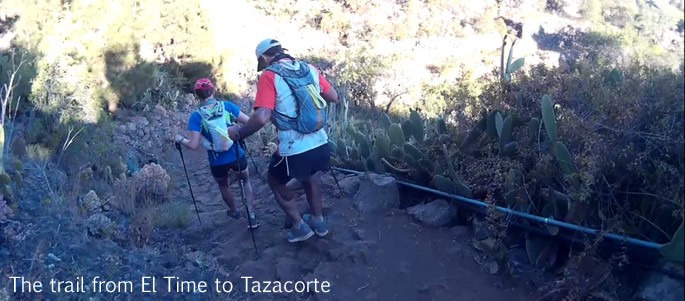
The trail to Tazacorte is roughhouse until you hit the tarmac lower down and then back to somewhere in between for the switchbacks of the last 200m to the beach. The pros just fly over this stuff but I was reduced to picking my way through it like a granny, poles catching in crevices. As I say, technique necessary! But it was full of anklebreakers and at an average slope of 15% a wrong move would have been calamitous. Gradually there was more civilisation.. the odd house, the first private car, comforts of home. Also a very cheerful bloke and his gang with a very large tub of red wine which he was thrusting on passing runners.
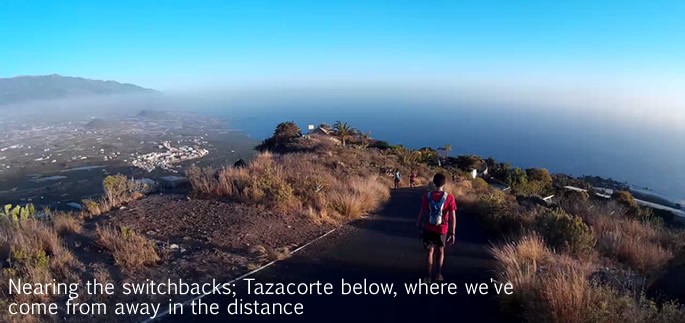
Heading towards the switchbacks, the sun was doing a better job of descending than I was and it was obvious I was going to be finishing in the dark - something I'd have given you very long odds against happening at 6am in the morning. Having recced this part of the trail there weren't any surprises except perhaps the sight of a couple of people throwing up. The music from the Tazacorte PA drifted up the cliffside and with each track I told myself I'd hit the beach before the next one started but it's a long and winding road down there (they didn't play that one thank god).
There were still a lot of people in Tazacorte and the kids are all in the market for hand slaps even with the partially decomposed version of Andrew Cooney, unidentifiable bits of lunch stuck in his nascent scrawny beard and various viscous fluids and mud stuck all over his person, that shuffles past.
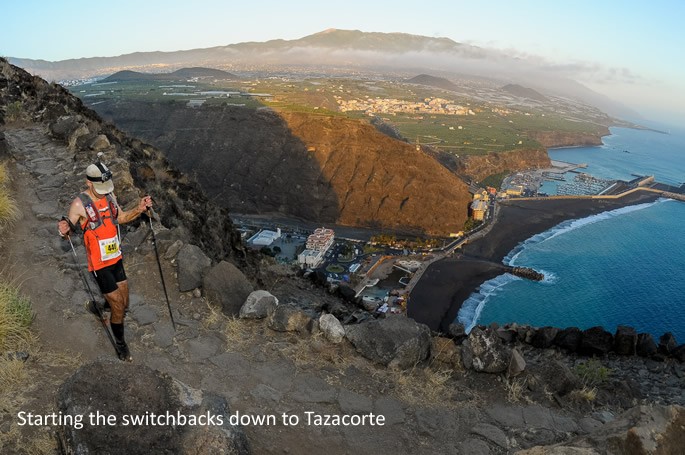
One last aid stop - one last refill of the bladder - three last cups of coke (I never drink this stuff outside an ultra) and it's the final stretch.
Now this has been a brutal course but it saves a real kicker for you at the end. Instead of finishing in Tazacorte at sea level where the marathon stops, it instead terminates 340m back uphill in Los Llanos. When you look at the course profile, it seems insignificant but that's because you're distracted by the rest of it. In fact it's twice the highest point on the South Downs in the last 5K. It starts off relatively gently though through a dry riverbed or gulley stuffed with all shapes and sizes of rocks and sand for a km or two but then kicks up viciously on yet more switchback cobbled roads.
I was stopped midway through the gulley and told to use the headtorch which I thought unnecessary as it was still pretty bright out, but by the time I'd put it on it was pitch black! So the climb was in the dark up a ridiculous gradient with the presumed destination lit by streetlamp away in the distance and high overhead.
The next hour will haunt me to the end of my days. The climb was relentless. Despite being at no significant altitude and with the sun gone, I was still unable to climb far without pausing to recover but it seemed worse if anything. At one point I sat down on a stone, panting like a hot dog and was still doing so 5 minutes later. I'd take a rest at each turn in the switchback; others either similarly in a state of collapse or urging on with more 'venga!'. It went on forever. I felt like lying down and waiting for death but somehow kept plodding on and eventually the cobbles ended and came out onto the streets of Los Llanos! What a massive relief.
There was still a fair way to go to the finish line but at least it was flat and the people lined the route and cheered on like we were winning the thing. The final red carpet is something special - I wish I'd been able to see it a few hours earlier when I'm sure it was a lot busier but the support from the crowd was immense, especially as they'd been standing there for probably more than 10 hours!
So unfortunately I was too smashed up to play along with the cowboy-hatted, prancing Michael Buffer guy who had reprised his VK role and I suspect my finish line photo is going to look quite shit but never mind (to be added when they are published!). I picked up the medal and a t-shirt and sat down on the nearest bench to gather my scattered forces, 16 hours and 15 minutes after leaving the lighthouse 45 miles South.
What an incredible day! Nothing like I expected. I knew it was going to be hard; I'd read at least 10 blogs on the race, spoken to people who'd run it, watched loads of videos etc. but in the end I couldn't deal with the heat on the day and it basically kicked me in the nuts. For that reason I don't know if I'd go again. I'd certainly want a much faster time and I do think I can run 10-11 hours but it may well be as hot again and that's difficult to train for. The hill training in Aus and NZ and the Black Mountains certainly was the right thing to do and I don't think I could have done much more of that, over the short term at least, as the knees were starting to protest! So we'll see. I will take away from it the fact that I at least persevered and finished and, with a 100-miler (the Centurion South Downs Way 100) on the cards in 5 weeks' time, spending that long on the feet is useful, as is not quitting.
It is an immense race. What an incredible experience. I've not run anything as breathtaking as that stunning course and everything about the race sets it apart. If you're a trail runner this has to be on your bucket list but there are no passengers in the field and 30% didn't make it on Saturday.
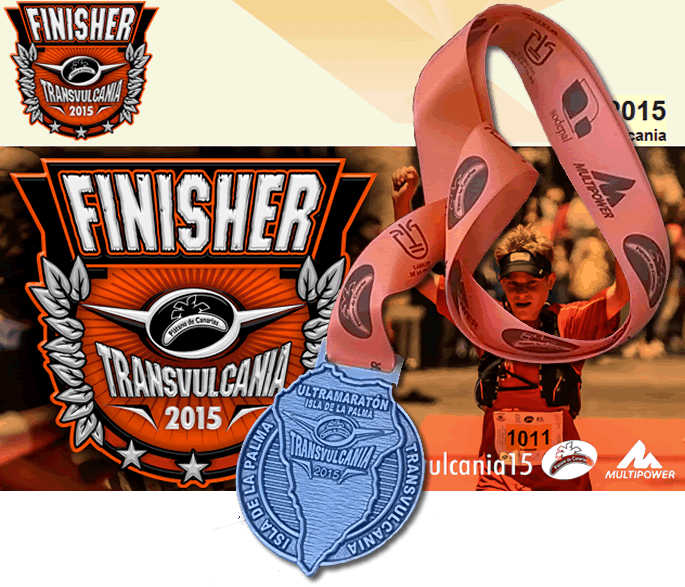
Transvulcania website
Official Results (Luis Hernando won in a new course record of 6:52:39 (insane), Emelie in 8:32:59)
Movescount track
Strava track


